As internal storage drives become faster with each generation, so are external and portable storage drives. Today we are checking out Crucial’s latest portable storage drive – the Crucial X8 Portable SSD. I’m not entirely sure why it’s called “X8”, but basically, it’s an NVMe SSD storage drive offering sequential read speeds of up to 1050Mb/s*. This portable SSD is an ideal solution for transferring files, especially large files, from one PC to another without taking too much time. It’s basically faster than any portable and even internal hard disk drives, and faster than other portable SSD drives. How fast you may ask? Continue reading our Crucial X8 Portable SSD review below and find out.
Crucial X8 Review – Is this the faster portable SSD you have been waiting for?
We are entering a digital age where files are becoming larger and larger; or we accumulate (large) files faster than before. A decade ago, USB thumb drives were already good, for transferring and transporting document files and other small files. Fast forward today and we not only save a few Megabytes of files, but we now have hundreds to thousands of Megabytes of files.
Transferring these larger files also requires a faster media storage. Otherwise it would take you so much time just to transfer the files to your external drive. That’s why we now have portable SSD drives as well, and not just portable HDD drives. Not to mention those portable HDD have a very low shock resistance and easily breaks when dropped from a certain height.
The Crucial X8 portable SSD is much faster than any SATA-based portable SSD, or non-NVMe portable SSD. It offers sequential speeds of up to 1050MB/s, making it a much better solution for transferring or transporting large file sizes like photos, videos, lossless audio files, game installers and etc. It can also be used to expand the storage on your PS4, XBOX One, iPad Pro or most of the Android devices.
Personally, I use this to copy and transfer my game files from one PC to another; and some of my media files (photos and videos) that usually takes several minutes to copy via an SD card or USB flash drive.
The Crucial X8 is compatible with Windows 10, 8.1 and MacOS. It’s also compatible with PS4 and PS4 Pro; and XBOX One and XBOX One X. For mobile devices, it is compatible with Android devices that supports USB Mass Storage over OTG and iPad Pro (2018 USB-C model) with iPadOS 13.
Now, let’s take a closer look at the product after the specifications table below.
Crucial X8 Specifications
| Capacity | 1TB | 500GB |
|---|---|---|
| Part Number | CT1000X8SSD9 | CT500X8SSD9 |
| Series | X8 | |
| Product Line | Client SSD | |
| Form Factor | Portable Solid State Drive | |
| NAND | Micron 64-layer QLC NAND Flash | |
| Controller | Silicon Motion SM2263 | |
| Speed | Up to 1050MB/s Sequential Read | |
| Interface | USB 3.2 Gen 2 Type-C (10Gbps) | |
| Compatibility | USB 3.2 Gen 1 a.k.a USB 3.0 (5Gbps), USB 2.0 | |
| Warranty | Manufacturer 3-year limited | |
Packaging and Closer Look
The Crucial X8 comes in a blue-white themed box; a familiar color scheme used in other Crucial products like the Crucial P1 and MX500 SSD.
The package includes the X8 portable SSD itself; a USB 3.2 Gen2 Type-C to Type-C cable; a USB 3.2 Gen1 (formerly USB 3.0) Type-C to USB-A adapter; and a quick start guide.
By the way, if you use the USB Type-C to Type-A adapter the speed will be limited to 5Gbps only. You will not be able to maximize the 10Gbps connection speed. To maximize its potential speed, you need to use the USB Type-C cable and connect or plug it to a USB 3.2 Gen2 (formerly USB 3.1 Gen2) Type-C port.
It’s not easy to open the X8, not that you need to open it in the first place. But inside the X8’s shell, lies an M.2 NVMe SSD attached to a M.2 to USB board. The M.2 NVMe SSD actually looks like a Crucial P1 NVMe SSD.
It uses Micron’s 64-layer QLC NAND flash paired with a Silicon Motion SM2263 controller and a 1GB DDR3 DRAM. That’s basically what the Crucial P1 is composed of. I wouldn’t be surprised if the performance is close to a P1. But it won’t be on par due to the limitation of the X8’s interface. So, let’s go ahead and see its performance.
Crucial X8 Review – Test Setup
In testing the Crucial X8 portable SSD, I am using an AMD system with and MSI MEG X570 ACE motherboard powered with an AMD Ryzen 7 3700X. Below are the rest of the specs of the system.
Operating System: Windows 10 Pro 64bit v.1909
Motherboard: MSI MEG X570 ACE
Processor: AMD Ryzen 7 3700X
CPU Cooler: Wraith Prism Cooler
Memory: Crucial Ballistix Elite 16GB DDR-4000
Graphics card: MSI Radeon RX 5700 XT Gaming X
Storage Drives: WD Black SN750 NVMe SSD 1TB
Power Supply: Enermax MaxTytan 1250W 80 PLUS Titanium
Out of the box, the X8 is formatted in exFAT for compatibility with Windows and MacOS. I tested the X8 in both exFAT and NTFS formats to see if there’s any difference.
Crucial X8 Portable SSD Benchmark Results
AJA Test System and ATTO Disk Benchmark Results
In our AJA Test system and ATTO Disk benchmark results we can see that the Crucial X8 performs very close to its advertised sequential speed of 1050MB/s, especially the read speed. It’s also worth mentioning that we don’t see any significant difference in the performance between exFAT and NTFS in these two tests. The X8 performed similarly regardless of the file system format.
The Crucial X8 is also faster than the WD MyPassport Wireless SSD, a portable external drive from Western Digital with wireless connectivity option and uses an SSD as its storage media. The X8 may not be as feature rich compared to WD’s MyPassport Wireless SSD, but it is definitely faster and smaller.
Anvil’s Storage Benchmark Results
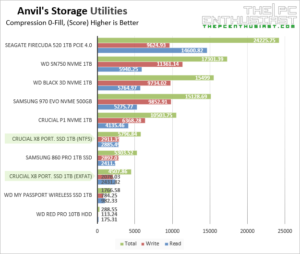
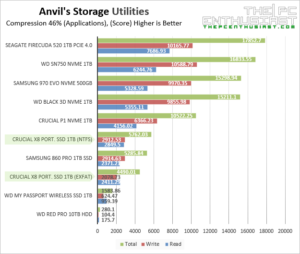
*Click images for larger view*
What you see on the graphs above for the Anvil’s storage test results are scores and not the actual speed. The higher the score is, the better and faster the drive. We can see that using the NTFS files system format, the Crucial X8 performs a tad better compared to formatted in exFAT.
Its performance is just on par with the Samsung 860 PRO and is far behind the Crucial P1 NVMe SSD. I was expecting that it would perform a little bit better but I’m not entirely surprised considering internal drives have the advantage than external drives. Also, notice that it still performs better than the WD’s Wireless SSD.
By the just, I forgot to mention, the WD MyPassport Wireless SSD was tested using wired connection and not via wireless connectivity. It is to maximize its potential speed as well and avoid bottlenecks.
CrystalDiskMark Benchmark Results
In CrystalDiskMark, we can see that the X8 performs better than the Samsung 860 PRO in sequential test, but lags behind when it comes to 4K random test. Notice that the write speed is also a bit better when using NTFS system format.
ezIOmeter Benchmark Results
ezIOmeter gives a more realistic scenario and what kind of performance to expect from a storage drive. In this test we can see that the X8 performs well when it comes to sequential test. Although it falls behind in sequential read, the X8 matches the sequential write speed of the Crucial P1 M.2 NVMe SSD. It’s also faster than the Samsung 860 Pro and WD’s Wireless SSD in this test.
However, when it comes to 4K random test, the X8 falls behind the P1 and the 860 Pro. Its performance isn’t that bad, in fact it’s quite acceptable considering that the MyPassport Wireless SSD significantly falls behind in this test.
Now let’s do some real-world copy tests.
Crucial X8 Real-World Copy Test
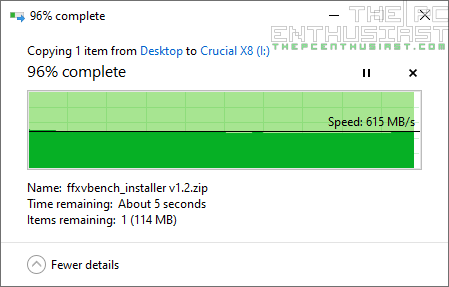
In this test, I used the Final Fantasy XV benchmark installer v1.2; it is a 3.65GB ZIP file. I copied it from two different sources, one from a WD Red Pro 10TB hard disk drive and the other from a WD SN750 M.2 NVMe SSD drive.
As you can see from the screenshots above, the X8 is clearly bottlenecked by the WD Red’s speed. Whereas if the file was copied from a much faster drive, in this case the WD SN750 M.2 NVMe SSD; the 3.65GB file was copied in just a matter of second. The screenshots show that it took “about 5 seconds” to copy, but it was actually faster than that.
Pricing and Availability
The Crucial X8 Portable SSD is now available. It comes with a manufacturer’s suggested retail price of $164.95 USD for the 1TB variant, and $119.95 USD for the 500GB variant. Crucial is also offering a limited 3-year warranty for this storage drive.
Crucial X8 Portable SSD SSD Review Conclusion
Crucial is known for their DDR memory modules and solid state drives. We have tested and reviewed several of Crucial’s products and we generally find them reliable with a decent price tag to match. The X8 is the company’s first portable SSD to hit the market. I don’t have any complains when it comes to its aesthetics or design. I think it’s nice and simple, however there are a few things that I would like to point out.
The Crucial X8 do get warm, especially the metal part on the middle area. So, if the drive has been active (reading and writing) for quite some time, be sure not to touch the middle / metal part immediately. The sides / “bumpers” are rubberized making it safer to touch or hold.
Another thing that I would like to see on this device, that is not currently present, is an LED power / activity indicator. There are no LEDs, so you can’t tell if the drive is active or not. Also, the included USB cable is a bit short, it would have been nice if it was a bit longer.
There is no hardware encryption as well or a security feature that would prevent others from accessing the drive. It would be nice if Crucial can add them in the future or to its successor. Finally, it would be nice if there’s a 2TB variant in the future. 1TB may be limiting for some and I wouldn’t recommend that you get the 500GB either; considering that the price difference from 500GB to 1TB isn’t that big at all.
When it comes to performance, for a portable external drive, I think its performance is great. I was able to reach sequential speeds of 1000MB/s as advertised. However, it does suffer a bit when it comes to random test. Nevertheless, it is still faster than any hard disk drive or other external non-NVMe SSD device.
When I checked the current pricing from online retail stores, the price is quite competitive, considering that it’s an NVMe SSD inside. Some portable SSD drives are either more expensive than the X8 or priced close to the X8. Even if the X8 is priced a few dollars more, it has the advantage when it comes to speed. Just make sure you are using the right cable and port to maximize its potential.
Finally, I find the Crucial X8 Portable SSD as an excellent external storage drive. It’s fast, built well and priced reasonably; and it does come with a 3-year warranty that is plenty enough for a portable drive.

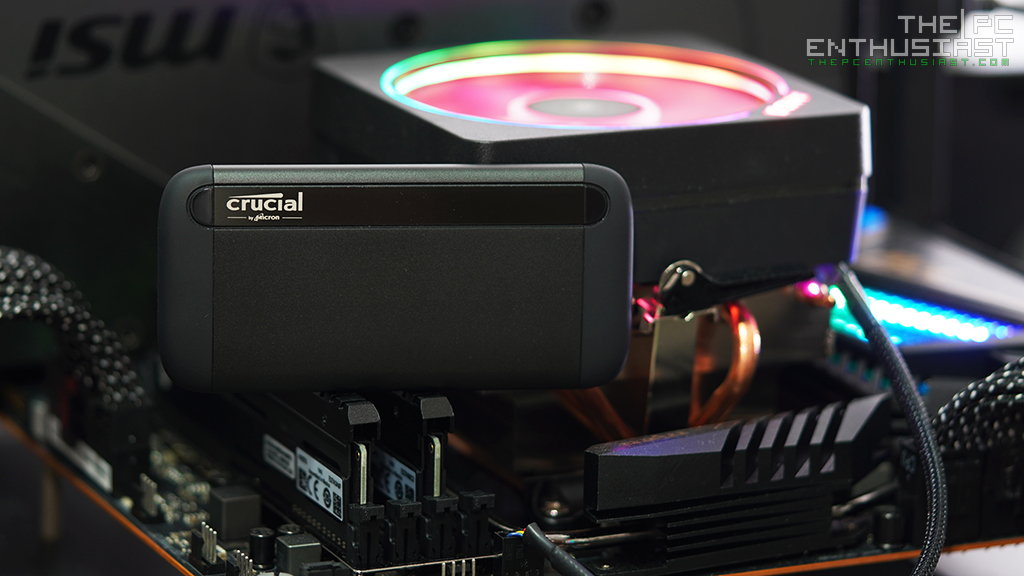
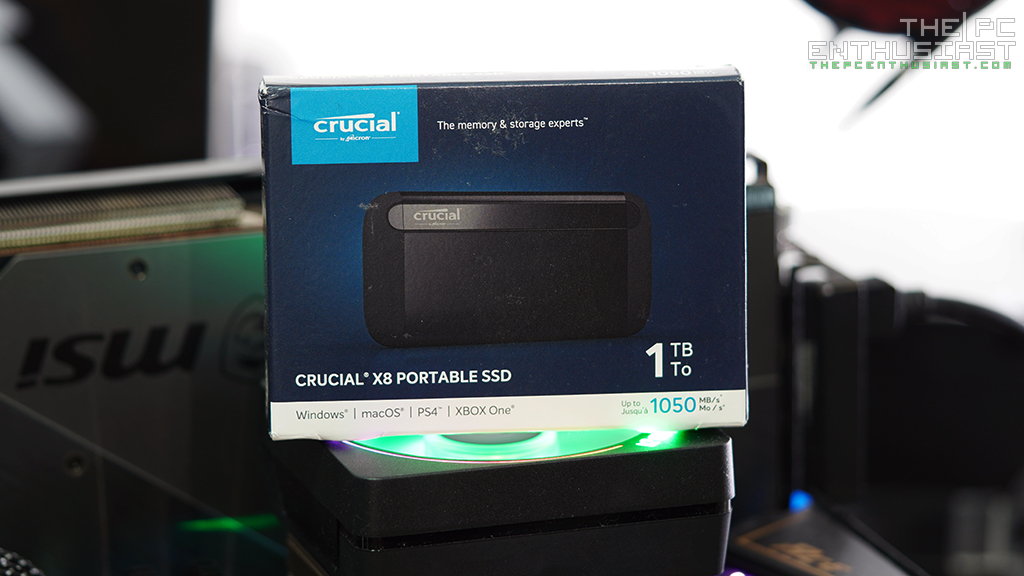



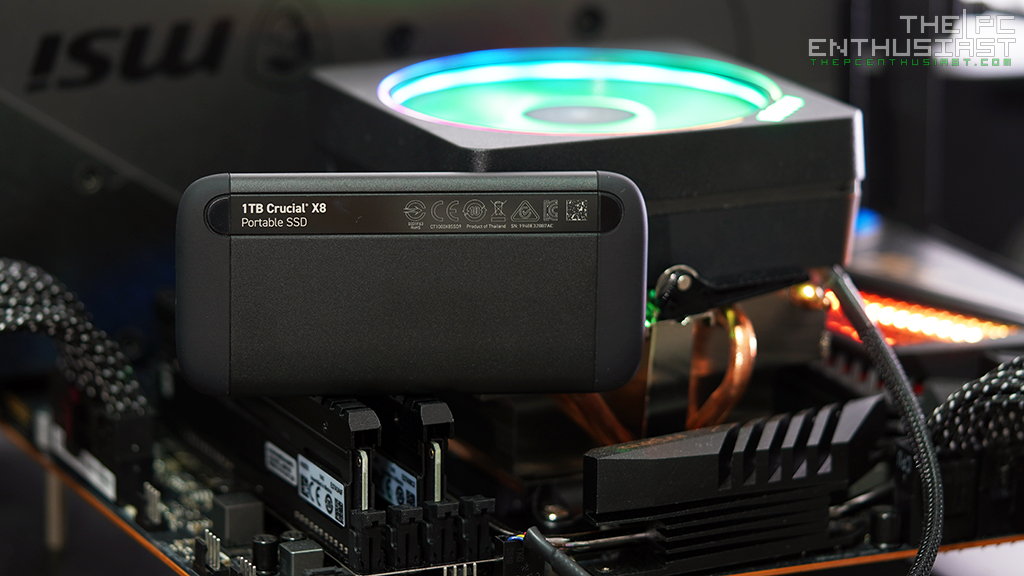
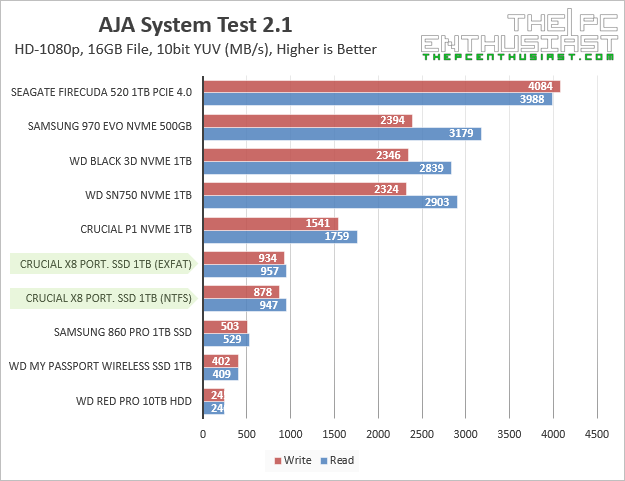
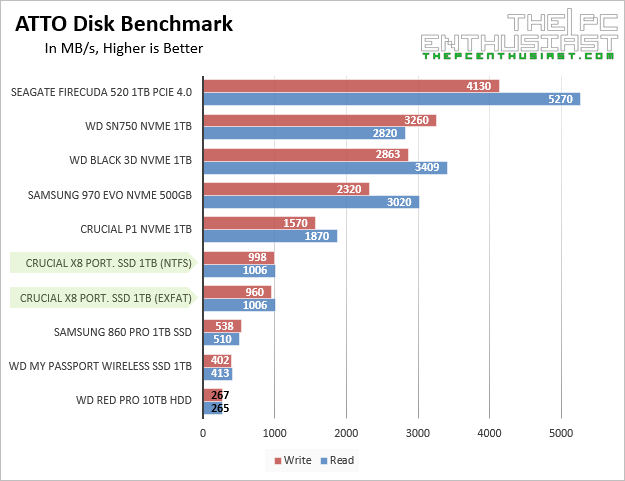
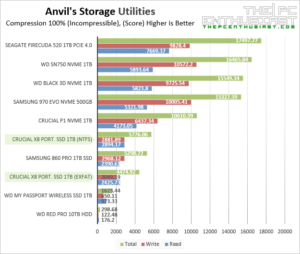
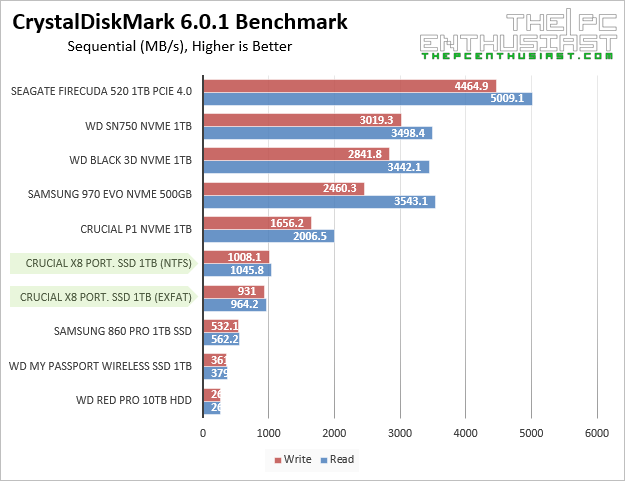
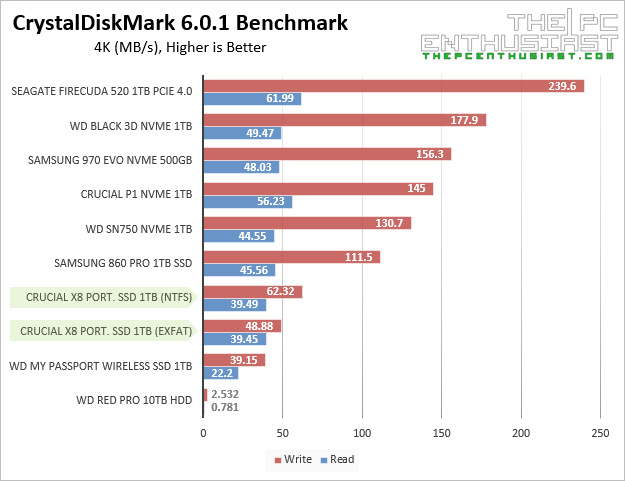
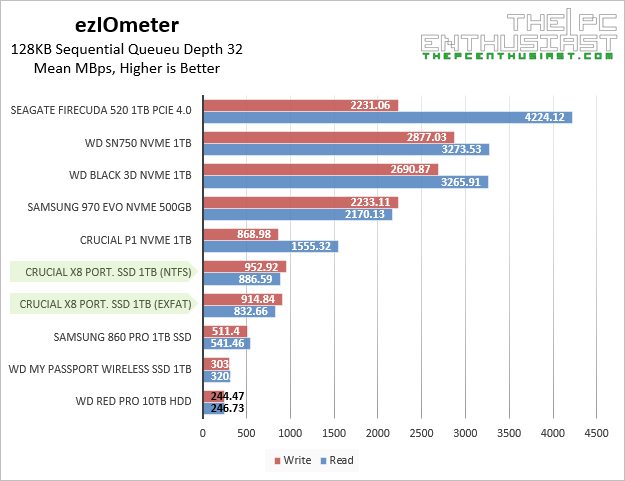

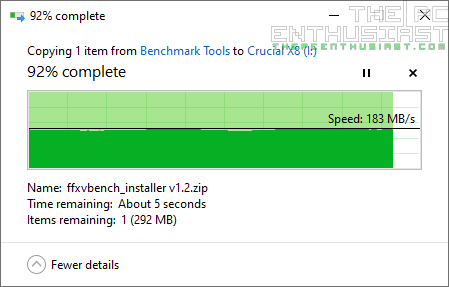

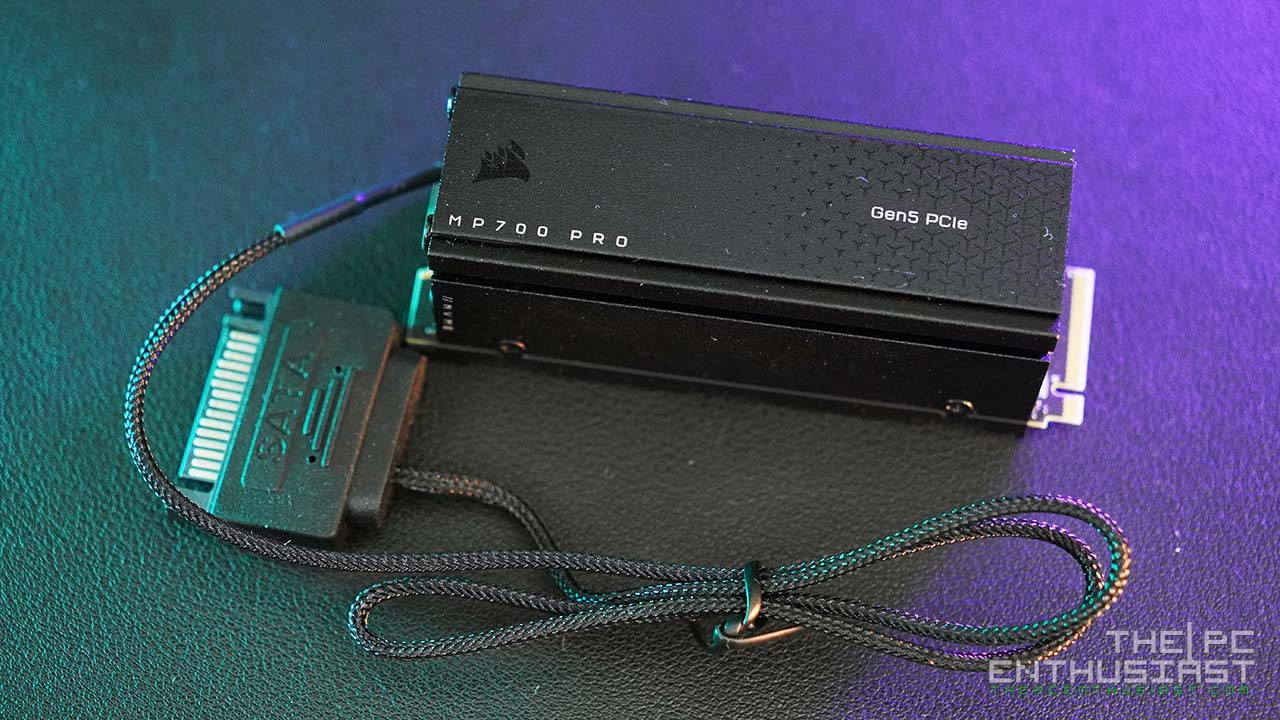
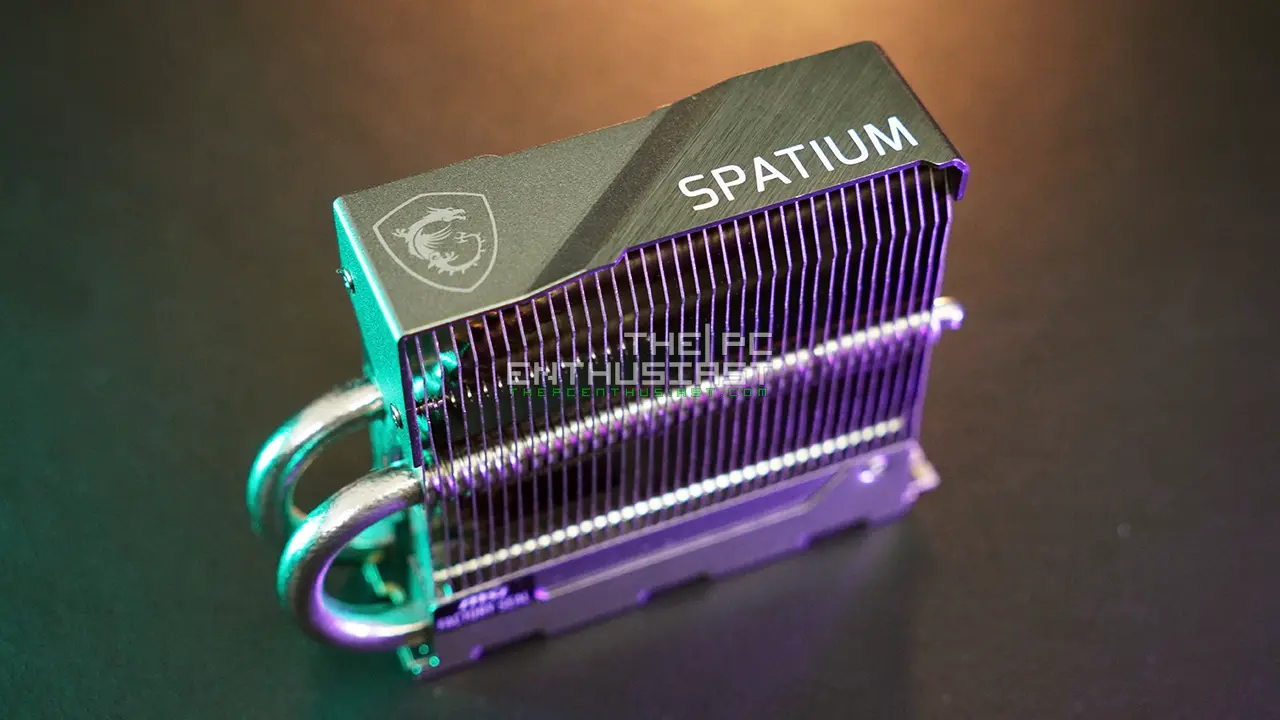
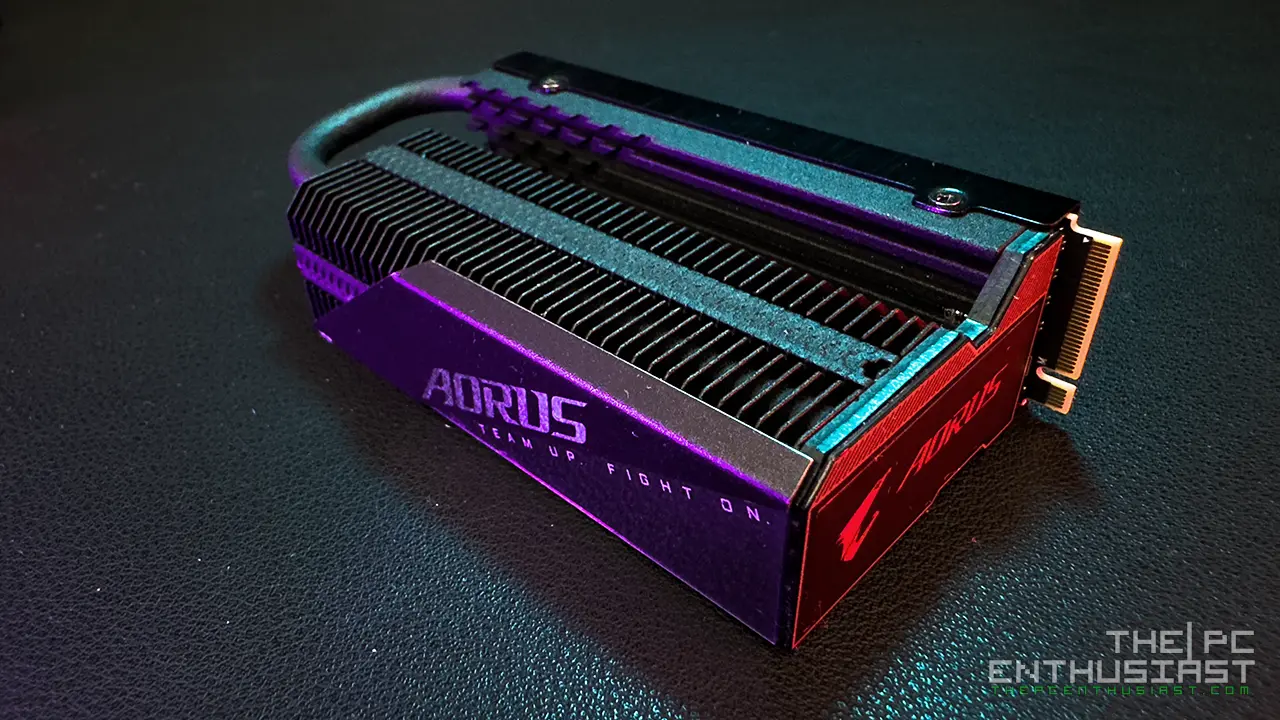
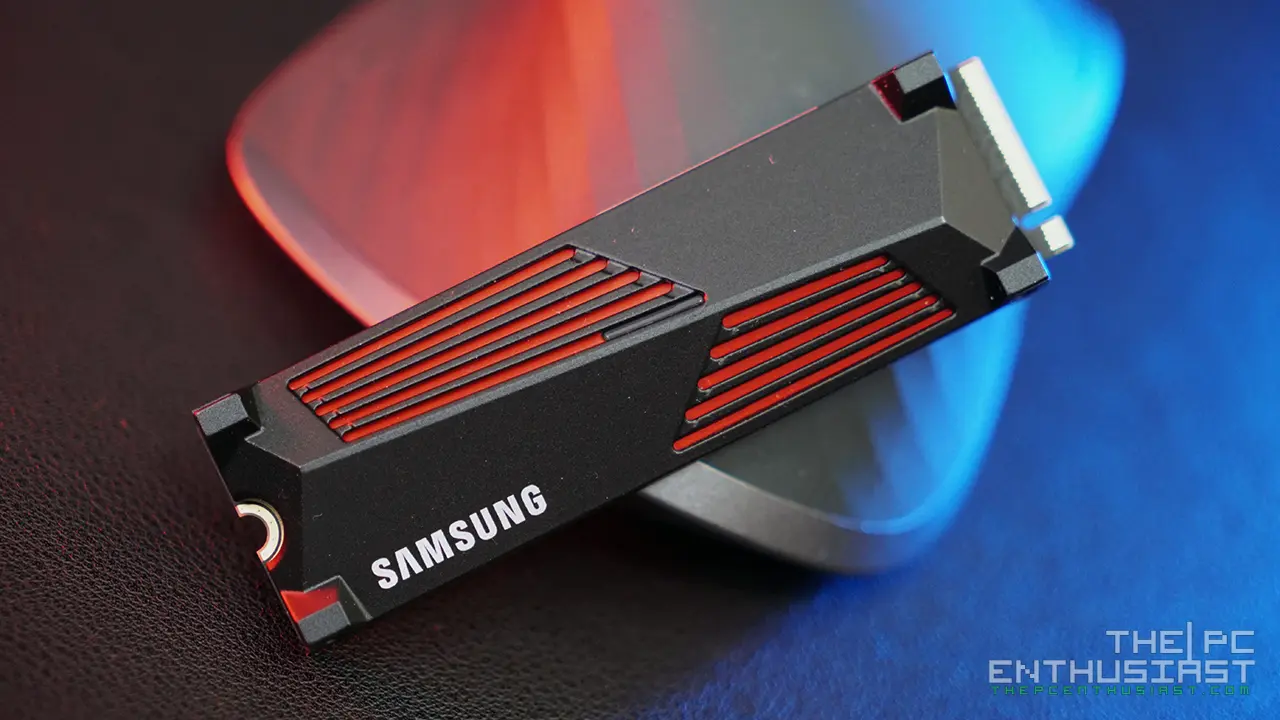
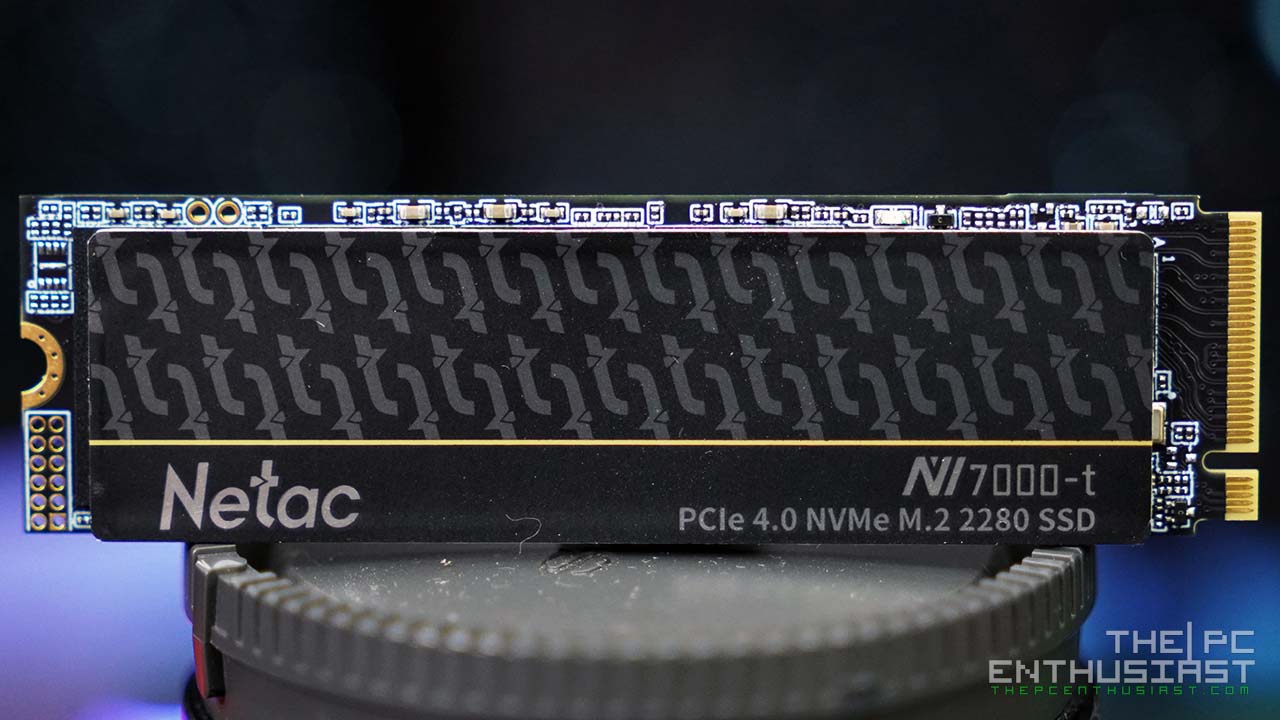
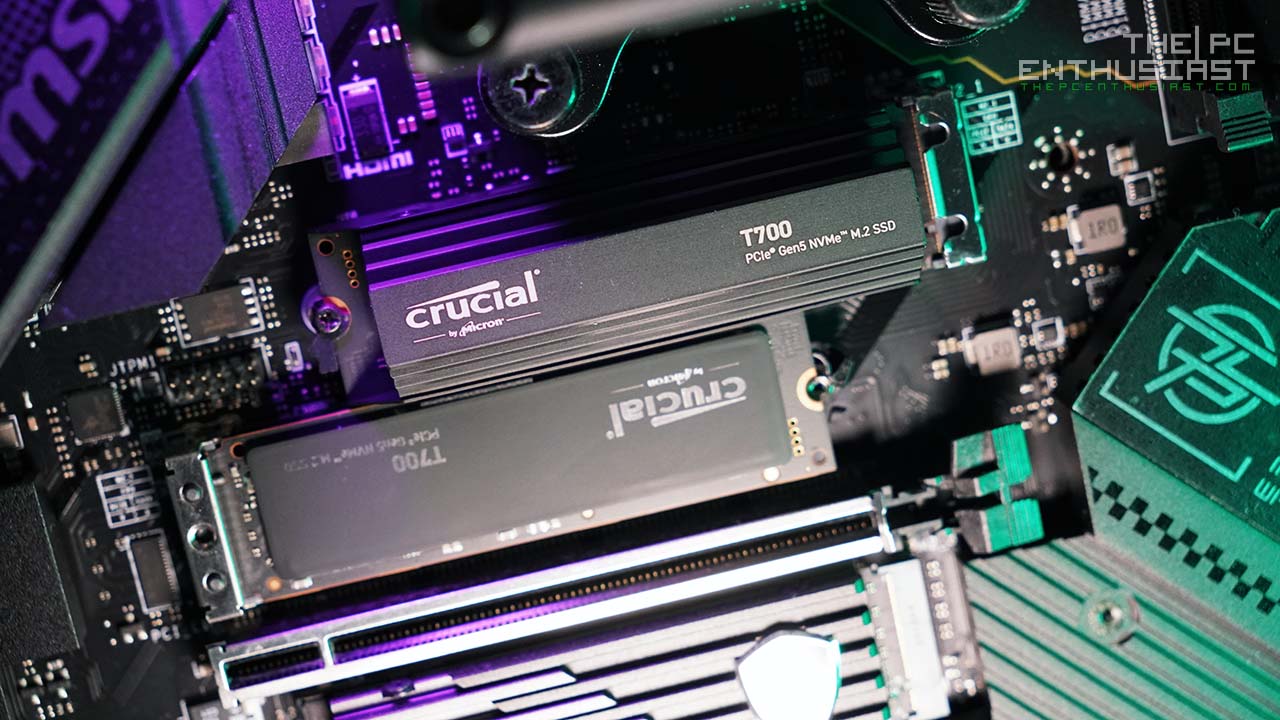

Just awesome. Was mentioning how many 5″ floppy disks I would need to backup 2TB of data, just the other day. On my 2012 MacBook Pro I just timed how long it too to write 10GB of video files to it. 33 seconds. Thats just under 2,500mbps. Which is fast. Perhaps when I finally upgrade my Apple MacBook in a year or so time that will come down to 8 seconds !
Absolute steal on Amazon this week and lowest price yet according to camel camel camel !